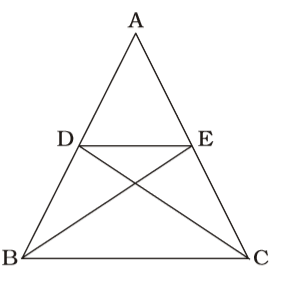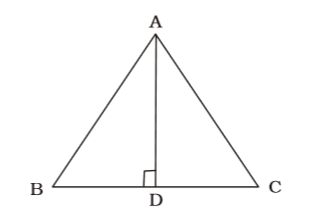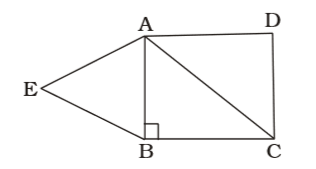Mensuration
- If the sides of an equilateral triangle be increased by 1 m its area is increased by 3 sq. metre. The length of any of its sides is
-
View Hint View Answer Discuss in Forum
Using Rule 6,
Side of equilateral triangle = x metre
∴ Difference of area = √3⇒ √3 [(x + 1)² - x²]√3 4
⇒ x² +2x + 1 – x² = 4
⇒ 2x + 1 = 4
⇒ 2x = 3 ⇒ x = 3/2 metreCorrect Option: C
Using Rule 6,
Side of equilateral triangle = x metre
∴ Difference of area = √3⇒ √3 [(x + 1)² - x²]√3 4
⇒ x² +2x + 1 – x² = 4
⇒ 2x + 1 = 4
⇒ 2x = 3 ⇒ x = 3/2 metre
- A straight line parallel to the base BC of the triangle ABC intersects AB and AC at the points D and E respectively. If the area of the ∆ABE be 36 sq.cm, then the area of the ∆ACD is
-
View Hint View Answer Discuss in Forum

∆DBC and ∆EBC lie on the same base and between same parallel lines.
∴ ∆DBC = ∆BEC
⇒ ∆ABC ~ ∆DBC
⇒ ∆ABC ~ ∆BEC
⇒ ∆ADE = ∆ABE = 36 sq.cmCorrect Option: B

∆DBC and ∆EBC lie on the same base and between same parallel lines.
∴ ∆DBC = ∆BEC
⇒ ∆ABC ~ ∆DBC
⇒ ∆ABC ~ ∆BEC
⇒ ∆ADE = ∆ABE = 36 sq.cm
- If area of an equilateral triangle is a and height b, then value of b²/a is :
-
View Hint View Answer Discuss in Forum
Using Rule 1,

AD = b
Let BD = DC = x
Each angle = 60° [∵ ∆ is equilateral]∴ tan 60° = AD BD ⇒ √3 = b ⇒ x = b x √3 ⇒ BC = 2x = 2b √3 ∴ Area of the triangle = 1 × BC × AD 2 a = 1 × 2b × b 2 √3 ⇒ b² = √3 a
Let AB = BC = AC = S Area of equilateral ∆ i.e. a= √3 S² 4
Also AD (height)√S² - 
S 
² = √S² - S² = √ 3S² 2 4 4 ⇒ b = √3S ∴ 2b² 2 a = 
√3S 
² 2 √3 S² 4 = 3S² × 4 4 √3S² = 3 = √3 √3 Correct Option: C
Using Rule 1,

AD = b
Let BD = DC = x
Each angle = 60° [∵ ∆ is equilateral]∴ tan 60° = AD BD ⇒ √3 = b ⇒ x = b x √3 ⇒ BC = 2x = 2b √3 ∴ Area of the triangle = 1 × BC × AD 2 a = 1 × 2b × b 2 √3 ⇒ b² = √3 a
Let AB = BC = AC = S Area of equilateral ∆ i.e. a= √3 S² 4
Also AD (height)√S² - 
S 
² = √S² - S² = √ 3S² 2 4 4 ⇒ b = √3S ∴ 2b² 2 a = 
√3S 
² 2 √3 S² 4 = 3S² × 4 4 √3S² = 3 = √3 √3
- ABC is an isosceles right angled triangle with ∠B = 90°. On the sides AC and AB, two equilateral triangles ACD and ABE have been constructed. The ratio of area of ∆ABE and ∆ACD is
-
View Hint View Answer Discuss in Forum
Using Rule 6,

AB = x units
BC = x units
AC = 2 x units [Using Pythagorus]∴ ∆ABE ∆ACD = √3 x² 4 √3 (√3x)² 4 = 1 = 1 : 2 2 Correct Option: C
Using Rule 6,

AB = x units
BC = x units
AC = 2 x units [Using Pythagorus]∴ ∆ABE ∆ACD = √3 x² 4 √3 (√3x)² 4 = 1 = 1 : 2 2
- Two triangles ABC and DEF are similar to each other in which AB = 10 cm, DE = 8 cm. Then the ratio of the area of triangles ABC and DEF is
-
View Hint View Answer Discuss in Forum
∆ABC = AB² = 100 = 25 ∆DEF DE² 64 16
= 25 : 16
[∵ ∆ABC ~ ∆DEF]Correct Option: B
∆ABC = AB² = 100 = 25 ∆DEF DE² 64 16
= 25 : 16
[∵ ∆ABC ~ ∆DEF]

